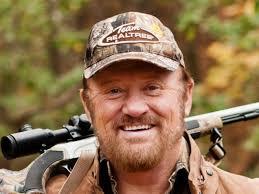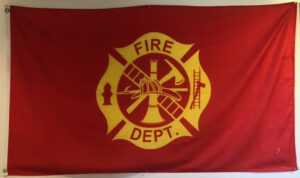
Today’s interview is with one of the heroes of Sassafras mountain. John Tarantini is the leader in the Wildcat community of the fire station on Monument Road. We would like to thank John for upfront his service. He makes us feel safer on a very unforgiving mountain. This marks the first of a series of articles with John. The transcript has been edited for content, but the full audio recording can be played above.

John was born the eldest of 6 children in a very Italian community of Pittsburgh, PA. He enlisted in the Marine Corps in order to get his higher education paid for under the VA. Unfortunately, as Vietnam grew much larger, he was assigned to a helicopter squadron right after enlistment. Within a few months, he was sent to the Dominican Republic on the Iwo Jima helicopter carrier to support the mission in Santo Domingo. Two months later, he served his first of two tours in Vietnam. He served as a Gunner, then Crew Chief, etc. Upon completion of his tour in SE Asia, he was assigned to Quantico, VA to instruct officers in Jungle insurgency. He and his squadron participated in over 30 named missions and over 3,000 flight hours.
Richard: John, you completed your service and were hired by a hotel company as Comptroller. 6 years later, you were promoted to General Manager, District Director, and finally VP of Operations. You were General Manager of hotels in over 30 states, and after several promotions, you ended up in Atlanta.
Of all the hotels you worked at, the hotel in Hollywood, California was probably the most interesting one. It was located next door to the Chinese Theater, which can only be described as Holly-weird. This is quite an impressive resume. Before we talk about the fire station, there are a couple of funny stories for you to tell us about. Why don’t we start with the jumper on the 22nd floor…
John: First of all, the hotel in Hollywood was the tallest building in Hollywood, at 23 stories. So when people went to commit suicide, they would do it from that building. We had a lot of strange guests. In this case, we got a call from the switchboard saying that a lady’s husband was going to jump off the balcony of their room. So we went up there with security, and security for the hotel was LAPD so they were professional police officers. We get up to the room, and she’s sitting there encouraging him to jump! So then we find out that he had peroxide spread all over his naked body, and on top of the peroxide was Vaseline. Supposedly, that was a high (or I guess it is to some people). We had to take him away in cuffs.
Richard: I’d hate to be the one cleaning him up! I understand your hotel was frequented by such celebrities as Debbie Reynolds and Captain Kangaroo. But not necessarily together…
John: Well Captain Kangaroo ate and drank in the bar a lot. A lot of people [today] don’t know who Captain Kangaroo is, but to our age group who live up on the mountain, they all know who he is. [At the hotel,] we had to help him to his room more than once. He drank like a fish. Debbie Reynolds lived in Hollywood Hills, which is above the hotel. So anytime something happened that made her not want to stay at her house, whether it was treatment by an exterminator or her house was just dirty that day, she’d want to stay at the hotel. But she would always call the hotel asking to stay for free.
Richard: And then there was the incomparable Cher. What was she like?
John: Cher stayed in the hotel a lot. You have to realize, our hotel was a tourist hotel. When people saw celebrities in the lobby, they would always take pictures, and ask for autographs. Once, Cher she stayed while filming her Cleopatra album cover at the Chinese Theater. She came to my office and said “I don’t want anyone to take my picture when I have my Cleopatra outfit on.” I had Security allow her through the back door and up the freight elevator to get her to her room so she wouldn’t be seen. She came back the next day and exclaimed that there was a crowd of foreign guests taking pictures of her in the lobby. When I asked “Why did you go through the lobby?” she replied “Well, they had to see me…”
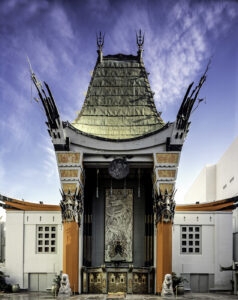
Richard: Isn’t that funny?! I suppose she was doing you a favor in a way, I would think the more celebrities in the hotel, the more of a draw for the hotel?
John: It wasn’t an unusual occurrence. A lot of actors stayed at the hotel while doing a screen test. A block away was Capitol Records, across the street is Max Factor. Paramount was close by [as well as] a lot of other movie studios.
Richard: I wonder if our audience can remember who Alex Haley is? Tell us about your experiences with him…
John: Roots was written in my restaurant. A lot of people [today] don’t know what Roots is, but at the time it was one of the bigger TV shows in the US. Alex Haley wrote it in a booth in the back of the restaurant. I even got a nice letter from him after he left.
Richard: Great stories indeed! Do any other memories of the hotel come to mind?
John: We had a revolving rooftop restaurant where people had dinner most evenings. I remember seeing the Watts Riots from the 23rd floor, and seeing the area burning in the skyline.
Richard: LA is quite a town… So you and your wife Elaine bought your first lot up on the mountain in 1997 and permanently retired up here in 2009.
John: We were the fourth ones to own a home in Monument Falls.
Richard: Wow, so you didn’t have all the traffic that you have now.
John: We also didn’t have the asphalt roads, they were pebble.
Richard: How was it getting up Monument?
John: It was paved until you got to Monument 1, from then on, it was all pebble. It was a challenge finding your lot. You had to make your way through thick forest using a machete to look for your marker.
Richard: Good grief! Just working in our back yard is almost unbearable up on the mountain. When you retired, it was your desire to give back to the community. You had offered 1 acre of your 10 acres for the Fire Station. Fortunately, that effort was already underway as Wildcat Inc., and Pickens & Dawson Counties had decided on a space.
John: Clayton [Preble] was working with Wildcat at that time, and when I made the offer to Pickens County, I didn’t realize that they had started on a fire station. I retired in 2009. When I saw how far they’d gone, I wanted to volunteer due to close proximity and due to the fact that us folks up here were 40 minutes from emergency services. My first year up here before the fire station, I paid $1000 more in insurance premiums than I pay now. That is because of the ISO rating of 9 or 10. We’re now rated 5 because of the fire station.
Richard: That’s huge, and is why the fire station is so important. Not to mention response times.
John: We cover a 5 mile radius of the station. For Monument Road, Sassafras [Mountain Estates], and Monument Falls, we average response times between 5 and 10 minutes max.
Richard: And you have to come to the station first?
John: The way we work is we divide the area up based on where the call is. For instance, if there is a call down on Upper Sassafras, [the responder] wouldn’t have to come up here. We pick up whatever we need from the station and meet them down there, so they would already be providing medical care by the time we got there.
Richard: Amazing. And you’ve pretty much kept 13 – 14 volunteers since day one?
John: Yes, though there have been some changes of people over the years. We probably have a core of 8 or 9 who have been on board since 2009. About 4 years ago, the state required us to be certified firefighters. This requires a lot more training, testing, and everything else. Out of the 14 people who currently volunteer, 9 are certified firefighters, 1 paramedic (Anita), and 12 of us are emergency medical responders.
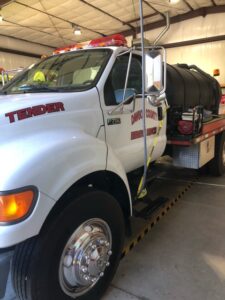
Richard: Where do you train?
John: We train at the burn building down near the north gate of Big Canoe. We train on live fire.
Richard: Not an easy thing. And most of our volunteers are getting up there in age.
John: Our average volunteer is 70 years old.
Richard: Can you believe that??
John: I can’t believe it now. Unless we get younger volunteers fairly quickly, the aging population of volunteers will begin to drop off. If you don’t have 4 firefighters, your fire station goes away.
Richard: And there goes your insurance.
John: I’ve recruited some individuals in their 30s and 40s who are waiting to train. We just need more of them. There’s other people who could volunteer and don’t. Because you volunteer doesn’t mean that you need to respond to every fire or medical call. You respond to the one’s that you’re available for.
Richard: What are the physical requirements?
John: There are certain things that you have to be physically able to do. If you’re a firefighter, you have to be able to pull a hose, walk or run a certain distance, put on fire gear, that type of thing. Same with medical care. You have to be able to carry a patient, provide medical care, etc.
Richard: Who pays for the supplies and equipment?
John: Pickens county, in addition to Wildcat who pays for some things.
Richard: You’ve mentioned Wildcat. What is that?
John: Wildcat is part of the national Department of Natural Resources program called Firewise USA. It’s for communities to get together and share ideas about preventative measures on fire and controlling the defensible space around your house. If we have a wildfire, it’s critical that the space around your house is relatively clear. If [your yard] is full of ashes, trash, and leaves that have fallen in your gutter, it’s going to catch on fire.
Richard: How far away should you keep combustibles like logs?
John: Typically 30 feet.
Richard: I need to move my logs.
John: We have an assessment program [that you can find more about] on the Wildcat website. The website is just for us, and it lists all of the assessments, studies, and tests that you can do. You’ll learn about what is considered to be definsible space, i.e. what to clear off and not clear off, and what to plant. The site can be found at wildcatcommunityga.org
Richard: What else do folks need to know about getting in contact with the department?
John: Don’t use Facebook. We think Facebook is a necessary evil, but people who communicate 911 things on Facebook certainly don’t know what emergency is. We won’t read it until it’s too late. Always call 911 if you need help.
Richard: And calls from 911 are routed to the station?
John: Correct. We all have radios and beepers. When you call 911, they’ll route the call based on location of your home to us. That happens no matter what county you live in, whether it’s Dawson or Pickens,
Richard: What would you say the station’s biggest need would be?
John: Besides a younger group of volunteers, the next most critical things is to have curbside addresses. There may be a POA issue, such as wanting the address plates to look the same, be upscale, or whatever the case may be, but if you’ve ever driven around here at night trying to find somebody’s home, good luck.
Richard: They miss our mailbox almost every time.
John: The other thing is that Monument has no mailboxes. They’re clustered at the top of the roads. Because we’re so familiar with where everyone lives, when we get a call we usually know where they’re at by name. The counties that come up after us, however, won’t know. [For the responders], you’ll see the green address markers in front of our homes that are reflective and can be seen at night. A lot of [houses] do it in wood or black on black, etc. I’ve driven past addresses because I couldn’t read it or it was only on one side. If a visible address can at least be put curbside (in front of the driveway), it will really help improve response times.
Richard: Here’s a funny question: A fire breaks out. Who do you save first, Angelina Jolie or Willie Nelson?
John: It depends, if my wife is reading this it would of course be wives first.
Richard: Good answer! This one has gotten to me personally. Can you talk about some of the issues you’ve seen with cars driving too fast and not paying attention up here?
John: Speed is the killer no matter what road you’re on up here. [We see a lot of] people going too fast, and construction trucks not paying attention. You’ll notice that a lot of people don’t walk on Monument Rd anymore because the speed has gotten out of hand. You also have a lot of construction going on up here. The construction trucks go flying around the corner, and the people are not used to driving these roads. We even had an assistant fire chief go off the road last winter, right into the ditch. It happens because they’re not used to it.
Richard: What about speed bumps?
John: We’ve asked the county for speed bumps on Monument Rd because people going to the park were exceeding the 25MPH speed limit. We were told by the commissioner that they were glad to put speed bumps on the unpaved road, but if we agreed to do that, they would no longer provide snow plowing. On the private roads, it’s a POA issue.
Richard: No issue with the firetrucks going over them?
John: It’s not the trucks you have to worry about, it’s the cars. What happens is the ice and snow collect at the bottom of the speed bump. When you try to get over the speed bump, it becomes ice slick and can cause you to lose control of the car. I had speed bumps when I lived up in Pennsylvania. Pittsburgh was a mountainous city. There were some speed bumps on the cobblestone streets, and I can tell you that it jerks the car. Especially if you’re not going straight, it can cause you to slide.
Richard: What else can be done to slow people down? Signage?
John: Well no one pays attention to the speed limit so it’s not going to be a sign. People could learn from examples of things that have happened that are not good. [When it comes to signage], you’ll notice we’ve had the county put evacuation signs up on the roads. We asked for that because people coming from the park, and due to the possibility of having a fire in Big Canoe or Bent Tree. Both can evacuate up here. We were concerned that they would come down Monument and turn into one of our subdivisions, making for a nightmare. If you’ve seen the video on Gatlinburg, where 2500 homes and 14,000 acres were destroyed, it was a nightmare with people driving down roads thinking they were going to be able to get out.
Richard: On another topic, I was slightly involved in a missing person search. When I heard about it, I came up here to the station and I was amazed at the organization that went into that. Can you tell use about how that’s put together?
John: Typically, we’ll get a 911 call saying that there’s a person missing, age, and what they were dressed in. We start doing a grid of our area up here. We get a lot of resources when there’s a missing person. We get county people, sheriff, other fire stations. The last time there was a missing person, we had almost 60 people looking for that person. They divide the 5 mile radius into grids, and people are assigned to look in that grid for that person.
Richard: Was there horseback?
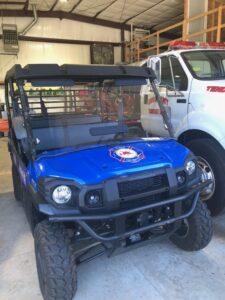
John: Yes, there was horseback and around 20 UTVs. We had 2 K9 crews from Cherokee too. We eventually found the person, and we found them in an area that we had searched before because they were trying to evade us. You assume the person who’s lost wants to be found. If they don’t want to be found they’re hard to find.
Richard: Is that a frequent occurrence?
John: No. Typically people overestimate their ability to walk or hike, and don’t realize they’re not in the shape to do that, then they get lost. Once that happens, they start going in circles, and walking in the woods is bad news at night.
Richard: Even hiking in the day can be treacherous when you don’t know the terrain. Now for our last question: What do you like about your work at the fire station? If there was one thing you could change, what would it be?
John: I like to give back. I like to see people in need get help. It’s gratifying to see someone who needs medical attention get it and survive. For instance, going to the hospital and they come back and lead a normal life from then on. As far as changing things, it’s a matter of getting younger volunteers. I realize there’s a dedication factor. You have to do 120 hours of training to be one of our volunteers and that’s a commitment.
Richard: But you get a cool radio right?
John: Yes, you get a radio and a beeper. You’ll wish you never had the beeper because when you have a fire it happens at 2 – 3 AM. Believe me, we get calls in the worst conditions you would think possible. Whether there’s a thunderstorm, downpour, lightning all over the place, trees coming down, then we’ll get a 911 call.
Richard: Well it seems like your life has always been one of service to other people. I can’t think of a better way for a person to live. I’ve really enjoyed knowing you and Elaine, and I’m really glad to call you my friends. Any last words or thoughts?
John: Bring more money to poker night.
And on that note, we conclude our interview with John. We thank John again for taking part in this article, and we can’t think of a better first interviewee for Jasper Mountain Life. Stay tuned, as we’ll be posting additional fire safety tips from John in an upcoming article. In the meantime, be sure to read John’s guide to winter preparedness on the mountain.
To get in touch with John or the rest of the fire department, visit wildcatcommunityga.org. Always dial 911 in an emergency.


